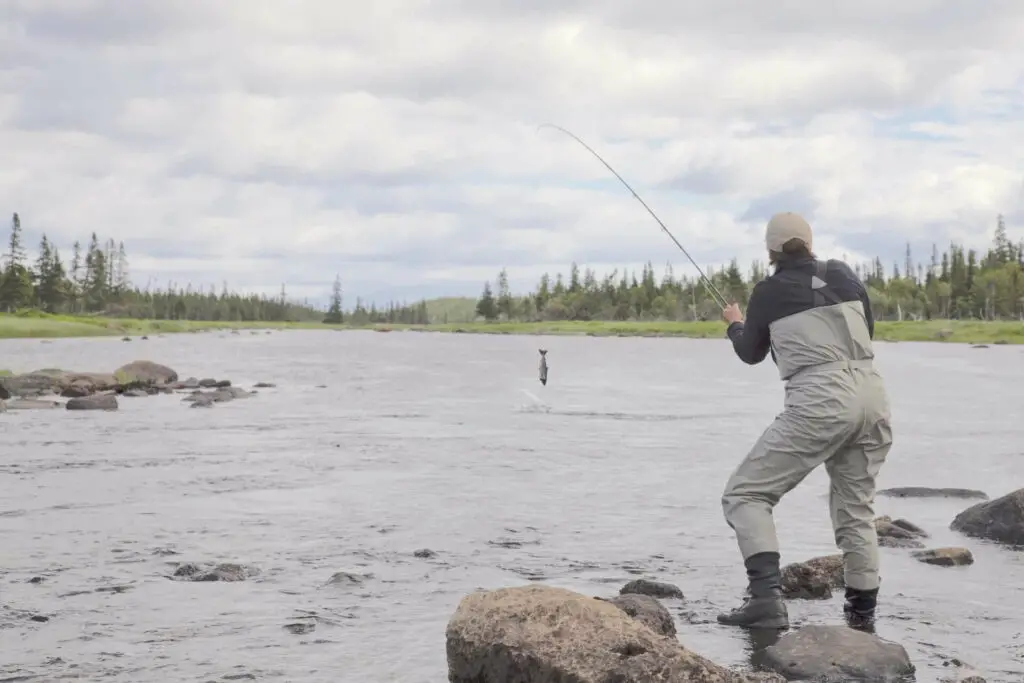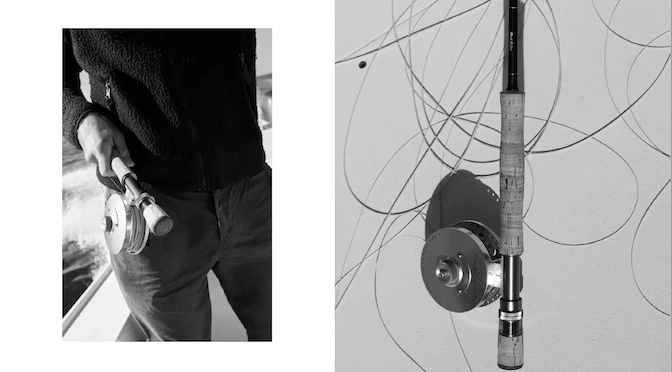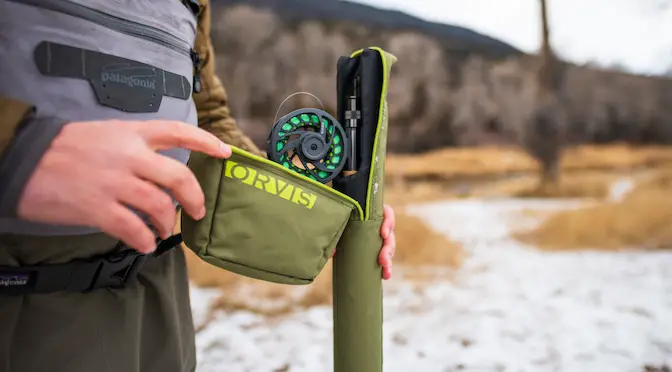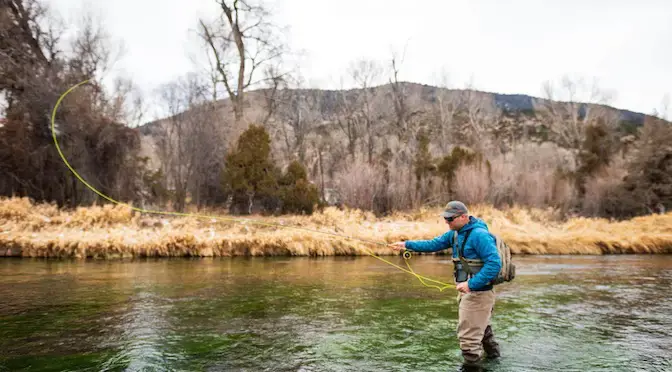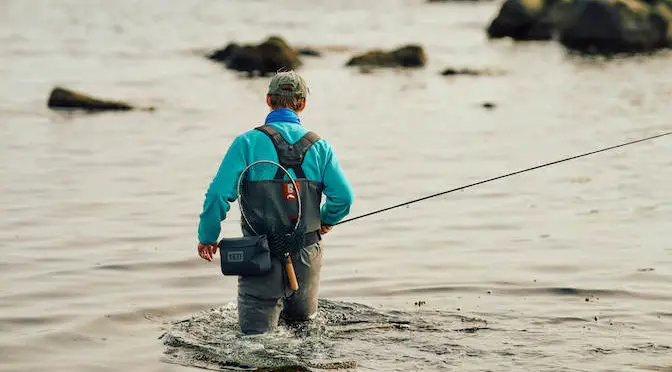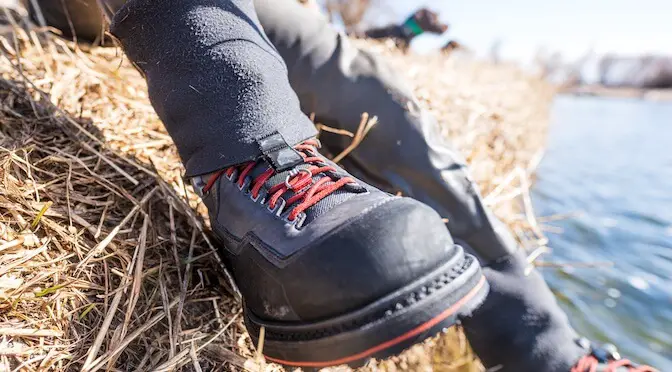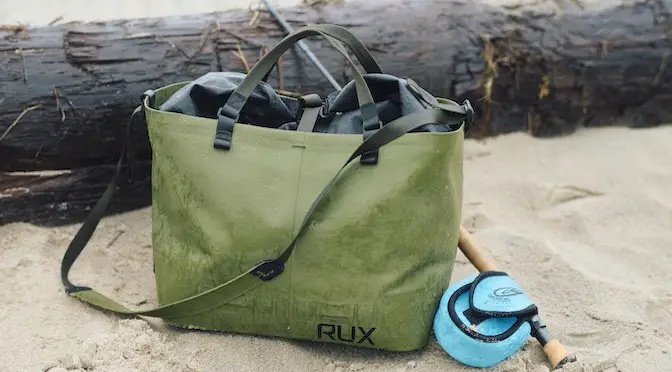Last updated on January 9th, 2024.
- Fly Fish Mongolia a Different Way – Part III - January 4, 2018
- Fly Fish Mongolia a Different Way – Part II - December 30, 2017
- Fly Fish Mongolia a Different Way – Part I - December 25, 2017
After four decades of dry fly fishing for Atlantic salmon I must admit that I did not often write about this wonderful, leaping silver fish.
Nor did I write about the special flies and techniques that I use to catch them. I wrote a lot about trout and grayling. And even more about my personal fishing flies or fishing techniques. Most of these stories have been very well received. To be honest, I have no idea why I hardly used the power of the pen to share my salmon secrets with the world. Probably I felt much more confident with all the experiences and skills that I achieved after so many years chasing trout and grayling.
Besides that, my special grayling flies were so well received that it was much easier for me to pen some words on them too. I indeed fished a lot for grayling, especially in the 80s and 90s and in those days, fly fishing journalists often described me as a real fanatic grayling junky. But in reality I put in many more hours fishing for Atlantic salmon then for any other species.
A Reason Not to Write About Salmon Fly Fishing
Perhaps one reason why I was so shy to share my knowledge of Atlantic salmon was a real bad experience from my early twenties. At that time I was still a greenhorn. I enthusiastically wanted to share my stories and experiences about catching salmon and sea trout on dry flies in the most northern part of Norway. Nobody believed me at that time. Dry fly fishing for salmon in the past was not very popular in Europe and a lot of people even called me a liar.
Some even laughed out loud and claimed that it was impossible to catch a salmon or sea trout on a dry fly. Those words were not spoken by unknown people because a few among them were quite famous. Luckily this nasty experience had an enormous “positive” impact on my fly fishing career. It forced me to isolate myself and continue to do what I was doing and what I believed in, while going my own way completely.
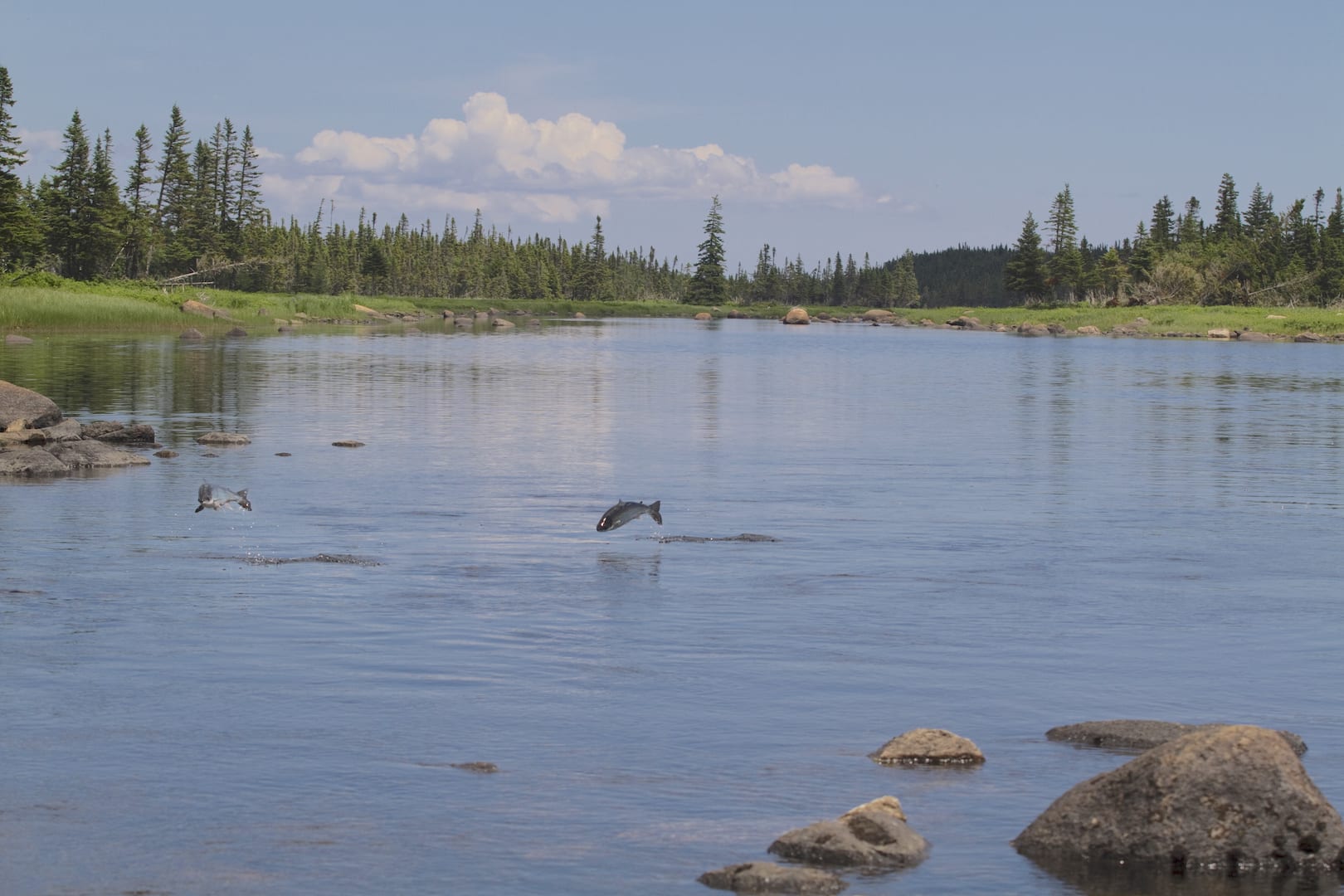 Synchronised salmon jump
Synchronised salmon jump
My salmon fly fishing history
Being a dry fly purist for Atlantic Salmon was harsh in Europe in the 70s and even early 80s. To me it looked as if I was a complete loner. But today I can proudly say that it was the perfect path for me to follow. The second problem I had was that the rivers I was fishing all were located in the most northern part of Norway. By train that was a very long way. So when my time as a student was over I had to change my fishing locations to the south and middle of Norway.
Lastly in 1988, after 17 years of using mainly dry flies for Atlantic salmon, I finally got full recognition. In front of nearly a hundred people I hooked and landed 15 salmon in just a few hours. All I used was one particular dry fly, the Klinkhåmer Special. This all happened at the Fosen Peninsula just below the Støvelfossen in the Stordalselva in Afjord.
The people couldn’t believe what I did. When I released most fish as well, it was seen as the action of a lunatic. In those days catch and release was not popular. The largest fish that I landed and safely returned to the river was 87cm (at least 7kg). I lost an even bigger one that kept me busy for several minutes. A local radio station announced that something really weird was happening below the waterfall. Hence more and more people turned up and in no time the whole area was packed.
The low water had made the river easily accessible and I finally had to stop fishing around 11pm. There were simply too many people walking behind me and I got worried about hooking somebody. The previous few days not many people had been fishing because of the hot temperatures. There had been no fish caught for some time. Together with a Finnish guy who caught nine fish using a Bomber, we wrote dry fly history that day. The hot weather and low water conditions were perfect for dry fly fishing. We both were very accustomed to fishing in conditions like these.
Journalist Terje Dybvik from Fosna-Folket wrote a full page story in the local newspaper about what happened on this particular day. He described it as an extraordinary experience, something he had never seen before. For me it was just one of the dozens of similar experiences I had made dry fly fishing for salmon, sea trout and sea run Arctic char in Norway over so many years.
 Salmon Klinkhamer and normal Klinkhamer
Salmon Klinkhamer and normal Klinkhamer
Big change in salmon fly fishing in 1988
When I caught my first salmon below the surface in the Bondalselva (also in 1988), I seriously started fishing for salmon with a wet fly more frequently. However, my interest in dry fly fishing for salmon and sea trout had become intense. I began to hunt for every article and story about Atlantic salmon or sea trout caught on dry flies. My search quickly lead me to fly fishermen and fly tiers who were familiar with fly fishing in Atlantic Canada, New Brunswick, Quebec and even in parts of the state of Maine, United States.
Meanwhile my Klinkhåmer Special had been garnering more international recognition. As a result, I was more easily able to make new contacts. I was a participant in the international fly tying symposium in New Jersey as one of the European fly tiers in the 80s. That helped me a great deal too. With further help from great friends like the late Alan Bramley from the UK, and the late master fly tier, Hans P.C de Groot from Holland, I was put in touch with other well known fly tiers and fly fishermen. These included Warren Duncan and Marc Madore from New Brunswick and Al Worthington from New Hope, Pa.
A long lasting Friendship
Beginning in 1981, Alan Bramley, the owner of the famous hook company Partridge of Redditch, became a big sponsor of my workshops and seminars. In 1989, after two years of testing my prototypes, he produced the first original Klinkhåmer hook after my own design. It was Alan who put me in touch with his very good friend Warren Duncan. Hans de Groot introduced me to Al Worthington. Slowly, utilizing old-fashion snail mail and handwritten letters, I started to build up a really meaningful exchange of correspondence with Al and Warren.
It didn’t take long before we were swapping flies and discussing our fishing techniques. Of course we also shared our experiences in catching Atlantic salmon on dry flies on both sides of the Atlantic. Al and I have developed a deep personal relationship although we have never had the opportunity to meet one another in person. He imported quality capes and saddles and was the owner of the Hackle Hut. I still have about 40 original letters from him, all written on his Hackle Hut note paper and some envelopes postmarked to me from his fishing residence in Nova Scotia.
All are filled with his latest fly fishing information, catch reports and fishing techniques. Sadly, I lost all the letters from Warren during a house renovation several years ago. I consider myself very fortunate that I still have some of the flies that he tied especially for me. They were meant for my trips to Nova Scotia, New Brunswick, Newfoundland and Labrador. I confess I have never tried them. They simply were too beautiful to fish with. So I copied them and have used the copies instead.
Warren was a great teacher and mentor to me, especially in perfecting my own hairwings. I still marvel at his ability to create tiny little heads even on bulky hairwing patterns. Unfortunately, I only was able to meet Warren once and, for me, he died much too early. Even today, it remains impossible for me to adequately express my deepest gratitude for what Warren and Al taught me and the information they shared freely with me. It is also with regret that after several years of communication and friendship we slowly lost touch with one another.
 A released salmon on the Robinsons river, Newfoundland, Canada
A released salmon on the Robinsons river, Newfoundland, Canada
In the Footsteps of Lee Wulff
In my eagerness to learn as much as possible about dry fly fishing for salmon, I am most pleased with the personal correspondence I shared with Lee Wulff. We began with a very technical correspondence in which we mostly discussed Lee’s dry fly experiences and successes in Newfoundland and mine in Norway.
Later, Lee was touched by my story and the fact that only a few people in Europe believed my catches of sea trout and salmon with dry flies. I think this alone, must have motivated Lee to help me. He sent me a few of his books and video tapes in return for some of my Klinkhåmer flies. I had included a handful of them in my first letter to him. I, for some reason, doubted that he would reply to me. But he did, and he even was willing to share with me some of his fly fishing secrets. They greatly increased my respect for him.
I had the pleasure of meeting him once and the last time we corresponded by letter was in early 1990. Thanks to reading his books and watching several of his videos, my excitement to visit Atlantic Canada had grown to a fever pitch. Lee died on April 28, 1991 near Hancock, New York when the Piper Super Cub he was piloting crashed into trees at the end of the runway during a takeoff. It was a big shock for me but it also pushed me a lot to see the rivers that he loved so much. A few years after Lee’s tragic death I was able to make one of the most exciting fly fishing journeys imaginable. It took me several years of holidays to follow Lee’s footsteps in Western Newfoundland and on the great Northern Peninsula.
The Bondal Series
Between 1990-1991 I sent a selection of eight of my first Bondal hairwing patterns to some friends in the USA. Several of the flies were still unnamed. They all loved to fish for Atlantic salmon, especially in Nova Scotia and New Brunswick. At the end of 1991, I began to receive a lot of very positive comments about the flies.
The most memorable one was from my American friend Dick Lemmerman. It seemed he had gone completely crazy over the Bondal Black and it had become his absolute favourite fly for the Margaree River in Nova Scotia. His enthusiasm and compliments got me to concentrate even more on my hairwing patterns. After seeing the pictures of his catches, I was hard pressed to believe all those nice big fish were all caught with my Bondal black and Bondal silver.
He sent pictures of his successes with my Bondal Black for several years in a row. I now know his stories first hand and they indeed are all true. Along the way, Dick took the liberty of renaming my black version of the Bondal fly “The Dutchman’s Balls” and to this day I do not know why he chose that name. He sadly took that secret with him to his grave when he passed away a few years ago. However, that name became so popular that I have to use it myself to prevent confusion when fishing in Nova Scotia.
Alterations of the Bondal Series
During this same period, I also received good feedback about two additional dressings of the Bondals series. As a result, I undertook more and more experimentation, which resulted in the evolution and creation of more hairwings. The series has become larger and larger since the first flies were designed. I should also add that the Bondal series led to the inspiration for my Pulsar series as well. My Pulsar flies are salmon patterns with a very special high pulsing effect that is absolutely deadly when water levels are just above normal or really high as well. .
I love a series of flies for trout and grayling and I have even developed a complete series for large predators in salt and fresh water. For Atlantic salmon I probably have more effective flies then I have for trout and grayling altogether. I have given away hundreds of salmon flies over the years. In a way salmon fishermen are a lot different to anglers who fish a lot for trout and grayling. Salmon flies often don’t work as fast as flies for trout and grayling. So people tend to lose confidence in them and change flies a lot faster. I believe this is why many people thought the salmon flies I had given them weren’t effective.
Today, the complete series of the Bondals contains 30 individual patterns. The big secret behind the major success of my special series of wet salmon flies is that each fly must have caught salmon in at least 15 completely different river systems before I put them in the series. This means that they really have to earn their place. Several flies in the series didn’t have a name at all. I just gave them a number and named only when I ran into something that was worthy of a proper name. Several of these named flies have already created their own incredible story.
The dressings didn’t change much over the years, but the patterns themselves went through some major modifications, as when I tied them on tubes several years ago. My close contact with friends like Dick Lemmerman, Jurij Shumakov and Bob Kenley, surely had a big influence on that decision. After I helped Jurij with a whole range of articles for some of his editorial works, he sent me some of his patterns in return for some further editorial work of mine.
I got hooked on his wonderful tube flies immediately, and the way Jurij had tied his new generation of tube flies stimulated me enormously to experiment with tube flies again. The last time I had fished with tubes was somewhere in the late 80s and early 90s in the Norwegian rivers Orkla and Gaula. At that time tubes and Waddington’s went through a little reintroduction process as well. Sadly Jurij’s accidental death shocked the salmon world and fly tiers worldwide and all our common plans abruptly came to an end as well.
 A selection of the Bondal series including Bondal black, Bondal silver, Tony’s First Choice and Where-Ya-Wanna-Be special
A selection of the Bondal series including Bondal black, Bondal silver, Tony’s First Choice and Where-Ya-Wanna-Be special
Fly Fishing Salmon Friends for life
My best salmon fly fishing friend is William Stephens (Billy) from Nova Scotia. We met in 1996 for the first time when he guided me at Cape Breton Island. On next to the last day of my trip I landed and released my biggest Atlantic salmon ever. I never use a landing net so I unhooked, measured and released the fish in the water.
This amazing fish was caught in the Long Run pool of the magnificent Margaree River with a 7 weight single- handed rod with 12 pound tippet (Maxima). Thanks to Bill’s help and all the tips that I got, I was able to read the crystal clear pools all by myself in no time. Billy told me several times that I did extremely well for the poor fishing conditions in that particular week of 1996.
The deadly fly was my Bondal Black, fully adapted to the heat by tying the wing as slim as possible. My way to create low water salmon flies. I also reduced the hook to a size four single hook with down eye. The fish measured 104cm with an estimated weight between 24 and 26 lbs. During an amazing week of fishing I had seen the most beautiful rivers in Cape Breton Island. I landed two grilse, one salmon and a lot of brook trout in the evenings while experimenting with large deer hair bugs for the first time in my life. The guided tour produced the closest friendship imaginable. Since then we have met every year for fishing and friendship and I have fished some of the Nova Scotia rivers dozens of times
A few last Words about Salmon Flies
Something else that I want to share with you is the fact that in certain areas you often see many fish caught with one particular fly. It really is something to think about. How often do we ask other salmon fishermen what flies will work best and do the job? Most of us tie on the fly that these people recommend to us right away.
One day in Newfoundland I saw 12 salmon caught in just a couple of hours by eight different people all using the same fly. It was the Blue Charm and when I talked to the fishermen most of them never use any other fly. So they never know if other flies will do better or worse. It is true most fish are caught on the fly that sees the water the most. I have seen the same happening with the Green Machine in New Brunswick, the Sunray’s Shadow in Norway and Orange Bombers in Labrador.
My personal strategy is a little different and when several people advise me to tie on a Blue Charm I purposely will use a completely different fly. Especially when the fish have probably seen the same flies over and over again. It works well for me just because fishing is also believing in your own tied flies, techniques and strategies.
Still today my research and experiments on Atlantic salmon are not done. I am still learning every trip that I make and every class that I do. I also have the fortune to do a lot of workshops on salmon fly fishing and during these workshops I can test out and try a lot of different flies. Who has ever tried to test the success of different flies when catches are really good? What I mean is that I like to change flies when catches are really good. I tell you why: it really gives you more answers and ideas than when you do the opposite, what most people do.
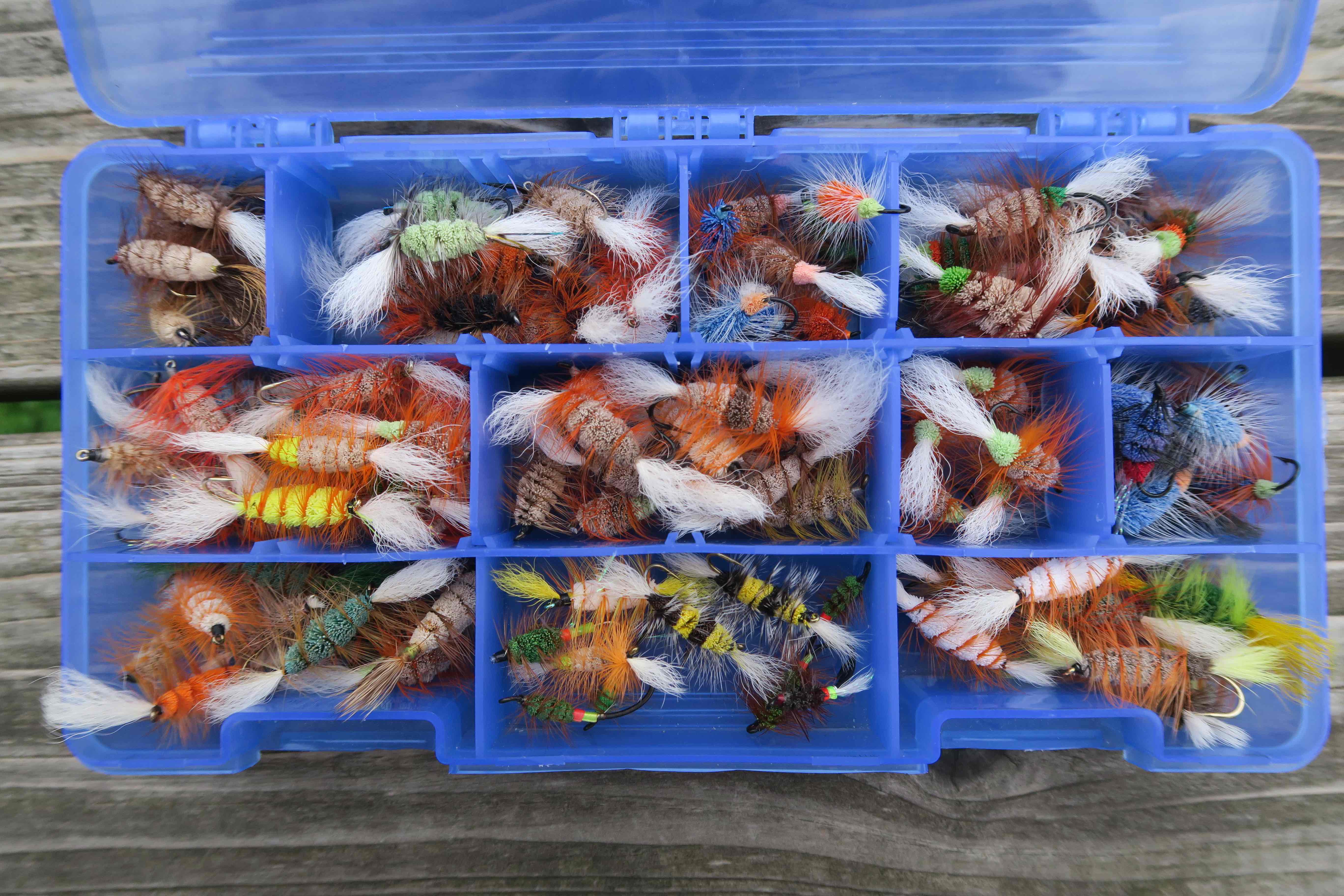 Larger dry flies that I use for Atlantic salmon in Atlantic Canada
Larger dry flies that I use for Atlantic salmon in Atlantic Canada
Lessons learned by experience and good observation
From earlier experiences, I have learned that as soon the air temperature gets higher than the water temperature, that is when you can start using dry flies for salmon. It is also used as a rule of thumb by several of my close friends. When air and water temperature get too warm it doesn’t work anymore, of course. When in midsummer the water temperatures get too high and the amount of oxygen has dropped to a critical level, most salmon will be hiding in deep lies. They put their noses down at the bottom and will avoid any activity, to save their strength for their upstream journey and spawning.
I don’t like rules for salmon fishing and I always keep in mind what Lee Wulff once told me: “The only definite thing that you can say about salmon, is that you can not say anything definite about them” and I really believe this strongly.
Another striking lesson that I learned in Atlantic Canada was that fishing rising water was not so good. But from the time it has peaked and starts to drop is a prime time for many rivers. In Norway, however, I experienced exactly the opposite; the best wet fly fishing for salmon was during rising water and I caught most fish during these periods. In both places I found dry fly fishing best at normal and low water levels. Personally I like a high but stable water level over a long period because I love to seek and find the new corridors that salmon take.
During more than four decades of salmon fishing I started with # 9 weight rods but nowadays I mainly use # 6 weights with low water and small rivers. I use # 7 weights for large rivers or high water. I tried double handed rods many times in rivers like Gaula, Namsen, Nidelva and Orkla but so far I can’t find the joy and satisfaction as I have with light single handed rods. I probably have fished too long and too intense with single handed rods. I don’t advice people starting with a # 6 weight for salmon fishing because you really have to grow into that. I also discovered that when you fish light, the fish leap a lot making them tired quickly and allowing a quick landing of the fish.
In general I am a poor caster and therefore my strategy is that I use the wind, the current and special fishing techniques as my most powerful weapons. Special leaders help me a lot in my presentation, while retrieving techniques can help to increase the mobility of my flies and certain knots even boost the wake around my surface flies when needed. I don’t use the Newfoundland or riffling hitch as most people do in Canada and Iceland but have developed my own knot with even more powerful results. Sadly this trick only works with down eye hooks and that’s why I developed a special salmon hook that I can use for bugs, bombers and my Bondal series at the same time (Daiichi 2110 and 2117).
The hooks are very popular in Atlantic Canada. Salmon are not shy fish but they can refuse all flies when they are stressed and disturbed. I learned a lot by good observation and while some salmon will come up for your fly once, others will do it twice or even five times. Sometimes when you know exactly when to change your fly, a salmon is in the mood to come up almost every cast. Of course that depenfs on which part of the world you are fishing. When I tell you that we have seen one and the same salmon come up more than 60 times. Grilse can do even more than that.
When I told people that I caught salmon using nymphs there was again a lot of disbelief. But I can assure you that I have hooked a lot of salmon using special nymphs. My first salmon was hooked on a (weighted) Montana nymph in the Stordalselva 1989 during heavy, rising water. I landed five more that morning. Since 1999 I fish frequently with un-weighted nymphs in Atlantic Canada.
In Norway and Russia you can fish for salmon with almost every fly and technique. In Canada there are a lot of rules that most European people are not familiar with. So in many rivers using doubles or trebles or even weighted flies and sinking or sink tip lines is not allowed. In some rivers you are not even allowed to do an upstream cast with wet flies and everywhere you must fish barbless. Most rules are made to prevent poaching and I am not in disagreement with them at all. In fact, I think they made me even more creative and inventive in my approach to salmon fishing.

